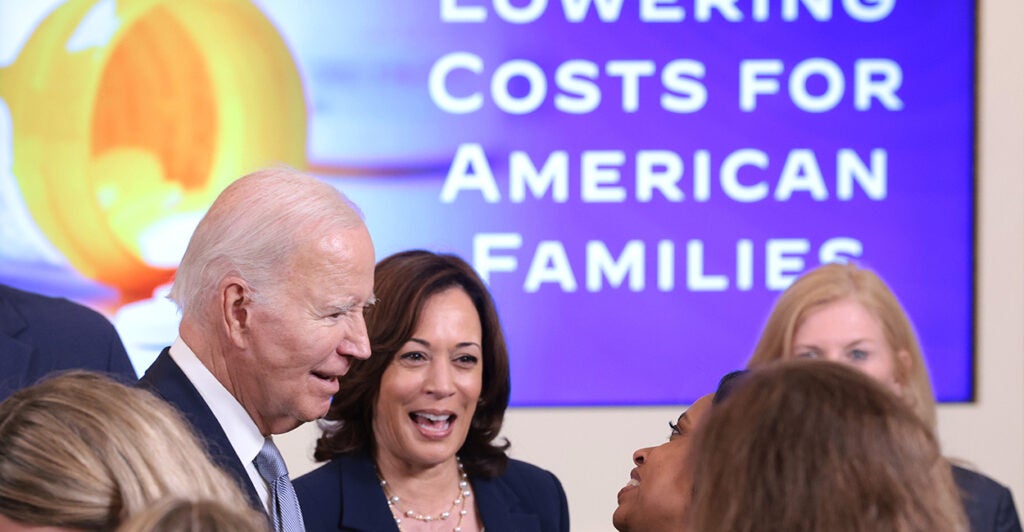“We finally beat Medicare,” President Joe Biden claimed during his calamitous June 27 debate with former President Donald Trump.
The White House later clarified: “He meant to say that he beat big pharma.”
But seniors’ wallets are taking the beating.
Changes made to Medicare’s prescription drug coverage by the Biden-Harris administration and congressional Democrats—with not a single Republican vote—as part of the so-called Inflation Reduction Act are sending premiums sky-high, eliminating plans for at least 3 million seniors, and making it harder to access medications.
The data shows that under four years of Biden-Harris administration policies (plan years 2022 through 2025), the national average monthly premium paid by Medicare beneficiaries for stand-alone Part D prescription drug plans has increased by 57%.
At the same time, the average number of plans offered in each state has dropped by more than one-half, from 29 in 2021 to just 14 in 2025.
Seniors in some states face even bigger hits to their wallets. Under the Biden-Harris administration, Medicare drug plan premiums jumped by more than 90% in 10 states. Premiums more than doubled in three of those states (California, 122%; New York, 116%; and Nevada, 104%).
On Oct. 1, seniors were able to start “window shopping” Medicare drug plans for next year and will be able to enroll in their chosen plans starting Tuesday, Oct. 15. Many of them already are expressing their sticker shock on community forms:
“So I just got a new notice telling me that my drug plan D (not an advantage plan since I am on SSDI in NJ under 65) the monthly cost for 2025 has doubled. Plan still makes me pay high cost for anything not generic etc. I thought this new law was to reduce my overall cost but reading the updated booklet (AARP United Healthcare plan) seems to me the higher cost is going to pad them not me.”
“… [my] husband’s increase was over 650%. And deductible also increased over 100%. You are going to want to check the formulary list if taking any prescription meds. One of the expensive meds husband is on wasn’t pricing out … when I went to the government website for [Aetna] SilverScript, it’s because it’s not covered anymore (nor is the generic covered) …”
“They are no longer offering the plan I have this year for next year. This company is only offering one plan D, not 3 like last year. My current premium is $9.90 and my 3 prescriptions have a $0 copay per month. The new plan is $44.90 with $5 and $10 copays per month. That is a huge increase.”
To prevent seniors from experiencing an even bigger sticker shock just before the Nov. 5 election, the Biden-Harris administration decided to spend—without congressional authorization or approval—at least another $5 billion. The spending is for a new “demonstration project” that pays insurers extra if they agree not to increase premiums by more than $35 a month in 2025.
Specifically, the project does three things:
- Applies a uniform reduction of $15 to the base beneficiary premium for all plans.
- Limits premium increases to $35 per month.
- Limits risk to plans (and increases taxpayer losses) by narrowing Part D risk corridors.
According to the Congressional Budget Office, this “demonstration project” will cost taxpayers $7 billion next year alone, with the program set to run for two more years.
Because the Inflation Reduction Act made the market much more expensive, taxpayers will pay another $10 to $20 billion in 2025, according to the CBO. So much for savings.
The CBO also said that its original score of the IRA undercounted the cost of the Part D changes by $10 to $20 billion.
The Centers for Medicare & Medicaid Services, or CMS, projected premiums would decrease in 2025. But that’s not reality.
What CMS is concealing is that the average monthly premium is increasing despite the demo, and many plans will cost significantly above the average.
Not only are premiums way up but coverage choices are way down and millions of beneficiaries are losing their existing plans. Once flush with plan options, the program is experiencing a devastating downturn.
Seniors have fewer plans to choose from in 2025 than at any point in the program’s 19-year history.
For instance, CVS Aetna offered three plans in every state in 2024 but discontinued two of them for 2025, one of which was the second-most popular of all plans in 2024.
Similarly, UnitedHealthcare and Mutual of Omaha also each offered three plans nationwide in 2024. For 2025, though, United is offering two plans while Mutual of Omaha has dropped out of the program entirely.
Higher premiums and fewer plan choices aren’t the only adverse effects on seniors stemming from the higher costs imposed on Medicare drug plans by Democrats’ Inflation Reduction Act.
Plans are trying to avoid the need for even bigger premium hikes by also increasing the coinsurance amounts that enrollees pay for prescriptions.
Making a bad situation worse, the Inflation Reduction Act’s drug price controls will start to take effect in 2026. Those price controls discourage investment in drug development and will reduce the number of new medicines.
The price controls also are likely to trigger secondary effects on Medicare prescription drug plans. Those will be in the form of changes to the placement of drugs on formularies and the imposition of utilization management strategies such as prior authorization and step therapy that restrict patient access.
Higher costs for taxpayers and consumers, and fewer treatments for patients. Now you know what “we finally beat Medicare” really means.
